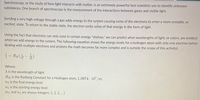
Chemistry
10th Edition
ISBN: 9781305957404
Author: Steven S. Zumdahl, Susan A. Zumdahl, Donald J. DeCoste
Publisher: Cengage Learning
expand_more
expand_more
format_list_bulleted
Concept explainers
Question

Transcribed Image Text:5. That's in the visible spectrum! Let's go further and find two more wavelengths emitted by hydrogen in the visible spectrum.
What's the wavelength of light emitted when moving from the 4th and 2nd energy levels?
3750 nm
375 nm
486 nm
209 nm

Transcribed Image Text:Spectroscopy, or the study of how light interacts with matter, is an extremely powerful tool scientists use to identify unknown
substances. One branch of spectroscopy is the measurement of the interactions between gases and visible light.
Sending a very high voltage through a gas adds energy to the system causing some of the electrons to enter a more unstable, or
excited, state. To return to the stable state, the electron emits scme of that energy in the form of light.
Using the fact that electrons can only exist in certain energy "shelves," we can predict what wavelengths of light, or colors, are emitted
when we add energy to the system. The following equation shows the energy levels for a hydrogen atom with only one electron (when
dealing with multiple electrons and protons the math becomes far more complex and is outside the scope of this activity).
= R#)
Where:
A is the wavelength of light|
RH is the Rydberg Constant for a Hydrogen atom, 1.0974 · 10’ /m
n2 is the final energy level
nj is the starting energy level
(n1 and n2 are always integers: 1, 2, 3, ...)
Expert Solution
This question has been solved!
Explore an expertly crafted, step-by-step solution for a thorough understanding of key concepts.
This is a popular solution
Trending nowThis is a popular solution!
Step by stepSolved in 2 steps with 2 images

Knowledge Booster
Learn more about
Need a deep-dive on the concept behind this application? Look no further. Learn more about this topic, chemistry and related others by exploring similar questions and additional content below.Similar questions
- 9. An electron in the hydrogen atom relaxes to the n =2 orbit and 434 nm light is emitted. What was the initial orbit of the electron? A: 5 Me g ou counoearrow_forwardA hydrogen atom in the n=4 state decays down to the n=2 state. What is the wavelength of light emitted? State your answer in nm. Note: wavelength is a positive number.arrow_forwardWhat wavelength of light is required to excite an electron to the n = 6 state in hydrogen? b. If that electron then relaxes to the n = 3 state, what is the energy of the photon emitted? What region of the electromagnetic spectrum is this emitted photon in?arrow_forward
- 2. What is the wavelength of light emitted when an electron in a hydrogen atom transitions from the n=5 to the n= 3 level?arrow_forward2. Rank the following regions of the electromagnetic spectrum from highest to lowest wavelength: visible (blue), infared, visible (green), ultraviolet, visible (red), visible (orange)arrow_forward41. Microwave radiation has a wavelength on the order of 1.0 cm. Calculate the frequency and the energy of a single photon of this radiation.arrow_forward
- This energy diagram shows the allowed energy levels of an electron in a certain atom. (Note: the SI prefix 'zepto' means 10-21. You can find the meaning of any SI prefix in the ALEKS Data tab.) energy (zJ) 1400 1200 1000 800 600 400 200 0 I B -A Use this diagram to complete the table below. What is the energy of the electron in the ground state? What is the energy of the electron in the first excited state? If the electron makes the transition shown by the red arrow, from A to C, will a photon be absorbed or emitted? Calculate the wavelength of the photon that would be absorbed or emitted. Round your answer to 3 significant digits. 250 ZJ 400 ZJ absorbed emitted nm x10 X Sarrow_forwardplease solve question 1 and 2, thanks alot sirarrow_forward1. Complete following table for regions of the visible region of the electromagnetic spectrum: Visible Region Wavelength Range (nm) Visible Region Wavelength Range (nm) purple/violet yellow blue orange green redarrow_forward
arrow_back_ios
arrow_forward_ios
Recommended textbooks for you
 ChemistryChemistryISBN:9781305957404Author:Steven S. Zumdahl, Susan A. Zumdahl, Donald J. DeCostePublisher:Cengage Learning
ChemistryChemistryISBN:9781305957404Author:Steven S. Zumdahl, Susan A. Zumdahl, Donald J. DeCostePublisher:Cengage Learning ChemistryChemistryISBN:9781259911156Author:Raymond Chang Dr., Jason Overby ProfessorPublisher:McGraw-Hill Education
ChemistryChemistryISBN:9781259911156Author:Raymond Chang Dr., Jason Overby ProfessorPublisher:McGraw-Hill Education Principles of Instrumental AnalysisChemistryISBN:9781305577213Author:Douglas A. Skoog, F. James Holler, Stanley R. CrouchPublisher:Cengage Learning
Principles of Instrumental AnalysisChemistryISBN:9781305577213Author:Douglas A. Skoog, F. James Holler, Stanley R. CrouchPublisher:Cengage Learning Organic ChemistryChemistryISBN:9780078021558Author:Janice Gorzynski Smith Dr.Publisher:McGraw-Hill Education
Organic ChemistryChemistryISBN:9780078021558Author:Janice Gorzynski Smith Dr.Publisher:McGraw-Hill Education Chemistry: Principles and ReactionsChemistryISBN:9781305079373Author:William L. Masterton, Cecile N. HurleyPublisher:Cengage Learning
Chemistry: Principles and ReactionsChemistryISBN:9781305079373Author:William L. Masterton, Cecile N. HurleyPublisher:Cengage Learning Elementary Principles of Chemical Processes, Bind...ChemistryISBN:9781118431221Author:Richard M. Felder, Ronald W. Rousseau, Lisa G. BullardPublisher:WILEY
Elementary Principles of Chemical Processes, Bind...ChemistryISBN:9781118431221Author:Richard M. Felder, Ronald W. Rousseau, Lisa G. BullardPublisher:WILEY

Chemistry
Chemistry
ISBN:9781305957404
Author:Steven S. Zumdahl, Susan A. Zumdahl, Donald J. DeCoste
Publisher:Cengage Learning

Chemistry
Chemistry
ISBN:9781259911156
Author:Raymond Chang Dr., Jason Overby Professor
Publisher:McGraw-Hill Education

Principles of Instrumental Analysis
Chemistry
ISBN:9781305577213
Author:Douglas A. Skoog, F. James Holler, Stanley R. Crouch
Publisher:Cengage Learning

Organic Chemistry
Chemistry
ISBN:9780078021558
Author:Janice Gorzynski Smith Dr.
Publisher:McGraw-Hill Education

Chemistry: Principles and Reactions
Chemistry
ISBN:9781305079373
Author:William L. Masterton, Cecile N. Hurley
Publisher:Cengage Learning

Elementary Principles of Chemical Processes, Bind...
Chemistry
ISBN:9781118431221
Author:Richard M. Felder, Ronald W. Rousseau, Lisa G. Bullard
Publisher:WILEY